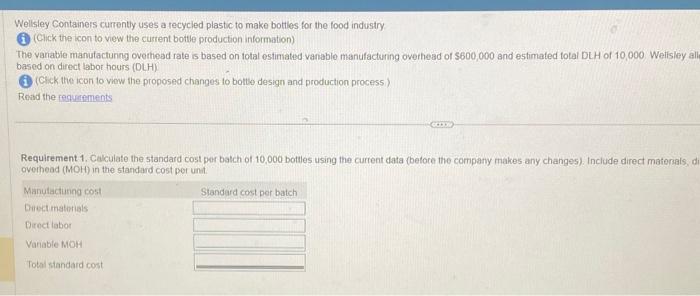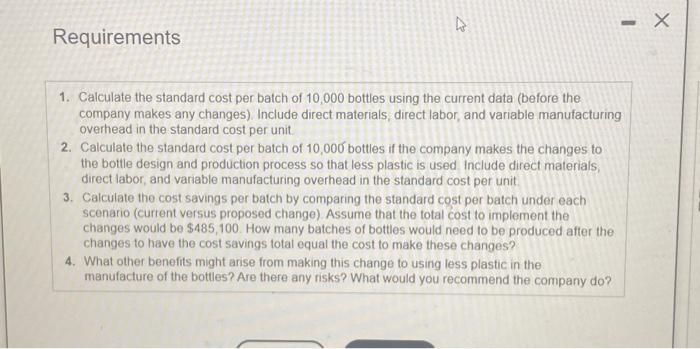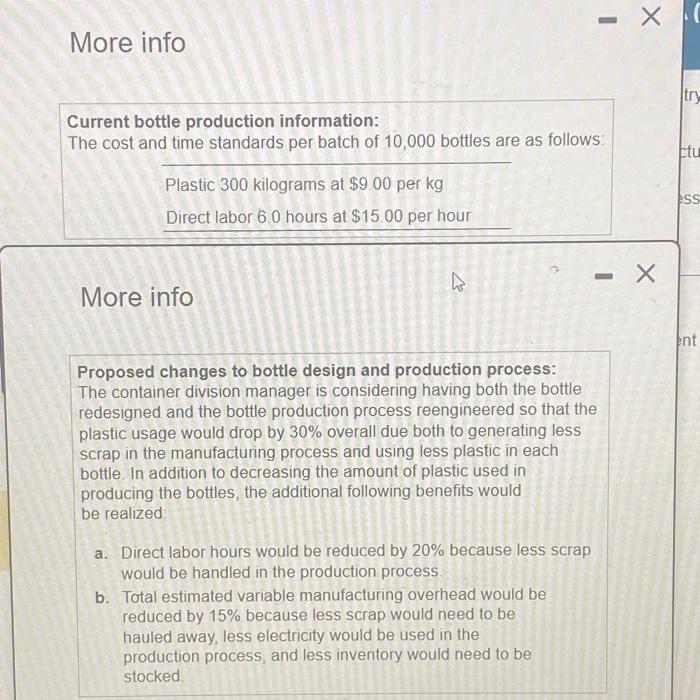Solve

Welsley Containers currently uses a recycled plastic to make bottles for the food industry (i) (Click the icon to view the current bottle production information) The vanable manutactunng ovethead rate is based on total estimated vanable manufacturing overhead of 5600 , 000 and estimated total DLH of 10 ,000 Wellsley all based on direct labor hours (DLH) (Click the icon to view the proposed changes to bolte design and production proces5) Resid the regurements Requirement 1. Cakcuiate the standard cost per batch of 10,000 botles using the current data (betore the company makes any changes). Include direct materiats, d overhead (MOH) in the standard cost per unt. 1. Calculate the standard cost per batch of 10,000 bottles using the current data (before the company makes any changes). Include direct materials, direct labor, and variable manufacturing overhead in the standard cost per unit. 2. Calculate the standard cost per batch of 10,000 bottles if the company makes the changes to the bottle design and production process so that less plastic is used Include direct materials, direct labor, and variable manufacturing overhead in the standard cost per unit. 3. Calculate the cost savings per batch by comparing the standard cost per batch under each scenario (current versus proposed change). Assume that the total cost to implement the changes would be $485,100. How many batches of bottles would need to be produced after the changes to have the cost savings total equal the cost to make these changes? 4. What other benefits might arise from making this change to using less plastic in the manufacture of the botlles? Are there any risks? What would you recommend the company do? More info Current bottle production information: The cost and time standards per batch of 10,000 bottles are as follows: Plastic 300 kilograms at $9.00 per kg Direct labor 6.0 hours at $15.00 per hour More info Proposed changes to bottle design and production process: The container division manager is considering having both the bottle redesigned and the bottle production process reengineered so that the plastic usage would drop by 30% overall due both to generating less scrap in the manufacturing process and using less plastic in each bottle. In addition to decreasing the amount of plastic used in producing the bottles, the additional following benefits would be realized: a. Direct labor hours would be reduced by 20% because less scrap would be handled in the production process. b. Total estimated variable manufacturing overhead would be reduced by 15% because less scrap would need to be hauled away, less electricity would be used in the production process, and less inventory would need to be stocked Welsley Containers currently uses a recycled plastic to make bottles for the food industry (i) (Click the icon to view the current bottle production information) The vanable manutactunng ovethead rate is based on total estimated vanable manufacturing overhead of 5600 , 000 and estimated total DLH of 10 ,000 Wellsley all based on direct labor hours (DLH) (Click the icon to view the proposed changes to bolte design and production proces5) Resid the regurements Requirement 1. Cakcuiate the standard cost per batch of 10,000 botles using the current data (betore the company makes any changes). Include direct materiats, d overhead (MOH) in the standard cost per unt. 1. Calculate the standard cost per batch of 10,000 bottles using the current data (before the company makes any changes). Include direct materials, direct labor, and variable manufacturing overhead in the standard cost per unit. 2. Calculate the standard cost per batch of 10,000 bottles if the company makes the changes to the bottle design and production process so that less plastic is used Include direct materials, direct labor, and variable manufacturing overhead in the standard cost per unit. 3. Calculate the cost savings per batch by comparing the standard cost per batch under each scenario (current versus proposed change). Assume that the total cost to implement the changes would be $485,100. How many batches of bottles would need to be produced after the changes to have the cost savings total equal the cost to make these changes? 4. What other benefits might arise from making this change to using less plastic in the manufacture of the botlles? Are there any risks? What would you recommend the company do? More info Current bottle production information: The cost and time standards per batch of 10,000 bottles are as follows: Plastic 300 kilograms at $9.00 per kg Direct labor 6.0 hours at $15.00 per hour More info Proposed changes to bottle design and production process: The container division manager is considering having both the bottle redesigned and the bottle production process reengineered so that the plastic usage would drop by 30% overall due both to generating less scrap in the manufacturing process and using less plastic in each bottle. In addition to decreasing the amount of plastic used in producing the bottles, the additional following benefits would be realized: a. Direct labor hours would be reduced by 20% because less scrap would be handled in the production process. b. Total estimated variable manufacturing overhead would be reduced by 15% because less scrap would need to be hauled away, less electricity would be used in the production process, and less inventory would need to be stocked










